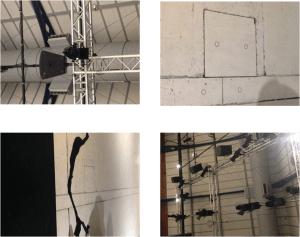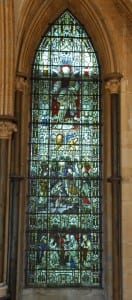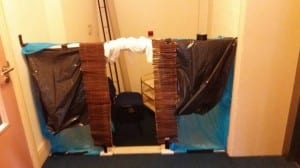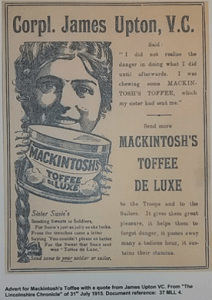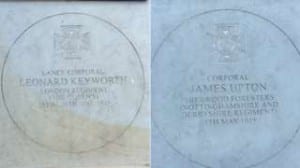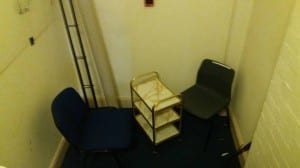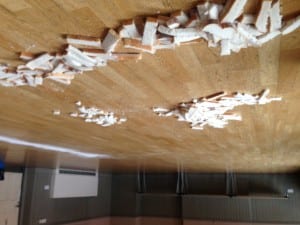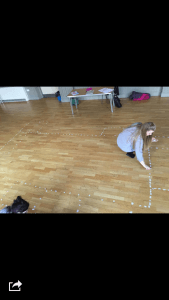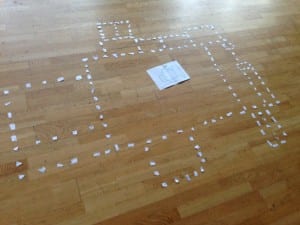“Site- specific performance may appropriate a pre-existing spatial configuration, annexing the architectural features of site to distribute its audience – staircases, balconies or the terraces of a sales ring, providing prospects unfamiliar or impossible to conspire in the auditorium.” (Pearson, 2010, 176)
“The Third Beam” is a site specific piece and installation and performance by three young women which took place at Lincoln Drill Hall. The Drill Hall was first opened to Monday, May the 26th 1890. The piece took place Wednesday 4th May 2016 beginning the installation at 12 which went on for five hours. Our performance was five hours long. Two hours were just being specific installation times, another three beginning at 14:00pm with the installation still being run behind the performance. It only involved 8 separate, one- to- one performances. The pilgrimage, installation and performance gives the public a brief encounter with the death of a 17 year old school girl during in her gym class. Her name was Rosamond Acworth. We chose to look at her death as it was unusual occurrence.

Our piece was held in the main auditorium, under the third beam where Rosalyn “did not fall” to her death. “Whilst the auditorium often locates performance ‘over there’, necessitating projection and a particular economy of vocal and physical rhetoric, site- specific performance many be ‘just here’, ‘up close’.” (Pearson, 2010, 176). The installations and pieces were placed approximately where we believe her death took place. From a visual of the pilgrimage we made from Lincoln Christ Hospital School, along with a 1900’s gym class being played behind the installation, you can see Rosamond’s ‘possible’ final journey from her school to the Drill Hall. We do not know if this is the actual route she took, but we took it upon ourselves to recreate her final journey. Our video showed us, walking, with a length of rope, down from the school and in to the Drill Hall. This ran for a few minutes and was developed whilst our performance took place.
From the first instance, when we delved in to the history of the place I looked for anything dark and slightly mysterious, but coming across a young girls death in the building came as quite a surprise to me. The location itself being a drill hall you’ll have expect the obvious, soldiers training and war time memories but not that it would have been used as a hospital, a saw mill, a gentleman’s club, a gymnasium, a place to hold to ballot papers for elections, or even a concert and performance venue.
Site specific was an extremely difficult module for me. At first when I entered the class I had no idea what it was about or what to expect. I didn’t know it was live art, installations, the history of a building, performances etc. Site has helped developed my outlook on ‘performing’ as a whole as it’s not just learning by script and developing character. It is fully comprehending and understanding the area’s history and how to re-enact a short period of a realpersons life.
The Process
“Our chief anxiety here might be of disorder, for no one seems to be in control” (125, Pearson)
Our process began when we began to look at the differing histories of the Drill Halls use. With so many to choose from it was always going to be a lengthy process. Once we had discovered that a young girl had died there, we knew we wanted to do something for her memory. We didn’t know what we we’re going to focus on but when we discovered there were different articles from old newspapers relating to her passing. We began to gather as much information as possible from divers source material concerning the actualities as to what had happened to Rosamond and began to look in to her cause of death. Finding out this information we discovered that she had died taking part in a gym class she didn’t normally attend.
Our trip to the local archives greatly assisted us in discovering the newspaper article which encapsulated the facts. We took a great deal from this. We originally decided to have the newspaper article being read over headphones for members of the public to listen to as they watched some video footage about Rosamond but that was later altered. This was changed as we didn’t have the time, nor the equipment to carry this on to its full potential. Changing this helped us figure out our idea for a performance piece and the installation.
Our process soon changed in to an installation and performance when we saw and chose the space we wanted to work in. We wanted to utilise the rope in our work, as it’s what she slid down during her cardiac arrest which lead to her death. We wanted to involve the everyday things Rosamond loved in our piece. That she was a librarian influenced our piece greatly. From this information you can begin to build a profile of a person, which we did. We decided to look at filling the room with as many books as possible. We came to the conclusion that we should use a book for every year of her life, leading to us using 17 books to commemorate her.
We decided to work out just where Rosamond “did not fall”. We found a square section under the third beam where it had been explained in the newspaper article, that she was 3ft up the rope before descending. The words “she did not fall” kept becoming prominent to us within the article as they we’re repeated.
We had to change multiple bits of our piece as they weren’t as fitting for as we thought they would have been. We didn’t want to make anything seem in any form offensive as we were working with death, which is an emotive subject and people can become easily offended or emotional upset by the information shared. Many of the public had no prior knowledge of Rosamond and there are no memorials to her in Lincoln, other than a stained glass window at the Cathedral, a prayer desk and a book case in her old school, Lincoln Christ Hospital School.
There were many different challenges we faced in site. One being the performance side. We couldn’t work out a way to have a performance with the installation. The performance side of the piece came much later in the process. We then began encountered problems in accessing information. Most people didn’t know anything about Rosamond until we began asking questions and gathering our information. The only source we gained information from we’re the archives, which gave us some history and clarity, such as the newspaper article, which helped our performance greatly, as it was a big part of our installation. The information from it was used to inform the audience, with correct facts about Rosamond. We originally had four members of our group, which quickly became three as a member wanted to focus on another project within the Drill Hall.
Our ideas which worked well were our installation, performance and pilgrimage. Our installation piece wasn’t originally a component part out our process as we were going to create a video of a pilgrimage, keep that on loop and just let the audience watch that whilst we read aloud the newspaper article. Changing that idea we decided to incorporate the 17 books. We decided to remove the pages from the books and write on them. What we would write would come later, but this would add to our secondary school girl aesthetic. For our performance, to have a time slot sheet, so members got a complete 1- to- 1 experience. Meaning they would get a completely new feel and almost be enveloped in a segment of Rosamond’s life. “What I find most exciting about One to One performance is the opportunity it affords the spectator to immerse themselves in the performance framework set out by the practitioner. This can be a seductive / scary / liberating / boring / intimate prospect and an even more intensive experience.” (Zerihan, 2007) The process would involve members of the public being brought in by one of us, having them having follow instructions including, closing their eyes – almost like a trust exercise. They would then be asked to kneel, whilst still having their eyes closed, and then asked to lay on their backs for the full experience of being. Meanwhile the spot light beamed down upon them. After they had heard Rosamond’s story, they were then asked to open their eyes and would be laid directly under the rope and the spot where “she did not fall”. This would be a personal experience for some participants. After they had been asked to opened their eyes and looked at the rope, they we’re then asked to stand and watch our pilgrimage, which would have been – perhaps – the last route Rosamond ever took from her school. Since we didn’t know the exact route we began at the school, walking down Wragby Road, then Lindum Road finally joining Broadgate to make our way to the Drill Hall. Our pilgrimage from her school became our pre and post-performance, followed by our installation and 1-to – 1. We walked from the Drill Hall back to the school to lay the lilies from our performance at her school gate. We also left a memorial piece at the Drill Hall, with 3 pages, 1 that each of us had written on during the performance and a photo of Rosamond, to enable more people to have an awareness of her.
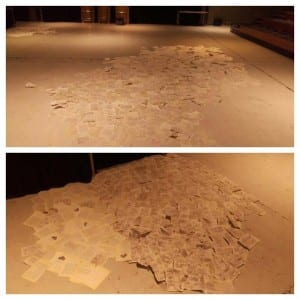
We had a lot of work we had to scrap within the piece. We we’re originally going to use headphones and a sounds scape to accompany our video. We ran our piece with both and concluded that we enjoyed the silence best with the piece as it gave a more personal and daunting experience instead of having sound which can make you less in touch with your other senses. Another piece we changed was where we we’re going to invite members of the audience to follow us up to the school and experience the walk. This was changed due to it being personal to us. Another piece of work that was changed but was left in the piece was the audience laying lilies within the spot light. These we’re intended to be a gift for Rosamond as a thank you from us for her story. We moved these to the school gates as we didn’t want audience members to end up having to lay within the lilies. We thought it would be a nicer gesture for Rosamond for us to take them to her school so she could ‘see’ that we and other people are still thinking about her all these years later.
Our inspirations were taken quite quickly after watching, ‘The Many Headed Monsters ‘slides and presentations. “The Many Headed Monster is an original and inventive resource for anyone interested in contemporary performance practices and their relationships with audiences.” (Sofaer, 2010)
During The Many Headed Monster video clips and presentations we came across William L. Pope. William L. Pope does many visual and public performances in the name of art. He is best known for a pilgrimage he did called “The Great White Way.” His crawl was 22 miles long and went on for 5 years. He was equipped with a skateboard and a superman costume. This piece influences used a lot for our pre and post- performance. It gave us a clear indication that we wanted to do a pilgrimage but not in such severe circumstances.
Another site performer who influenced us a lot, was our very own, Michael Pinchbeck. His piece “The Long and Winding Road” influenced our use of speech and text in the sense of everything was complete truth. We would have a direct conversation with a singular audience member but not make much eye contact with them as they were told to follow our instructions and keep their eyes closed for a lot of it. “In 2004, Michael embarked on a five- year live art project. He packed a car with the belonging of his brother and drove to Liverpool where he died in an accident in 1988.” (Pinchbeck, 2009)
Reflection
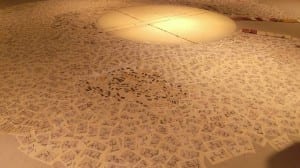
We had 8 members of the public to sign up to participate with our performance piece about Rosamond, but freely let members of the public walk through the auditorium so they could see what was happening during our performance if they didn’t have the chance to sign up. A clear estimation of the audience members walking through and around throughout the day would be about 40 members of the public. The estimation made, I would say all of them learnt new information about the Drill Hall and the incidents that had taken place there.
Our group got a lot of praise from the audience. Their involvement was all much appreciated even with the problems we encountered with one woman not being able to participate in the laying on the floor part. She could not do this due to disability, but we worked around it and she was extremely thankful to us for involving her and making Rosamond’s life known in hers. Every reaction was different, the first audience member seemed quite shocked about the information we were telling him but the rest of the audience seemed intrigued and thankful that we had made her life known.
The final performance for me as an individual did not trigger new ideas. I thought our performance was well rehearsed and worked incredibly well with the installations. Our performance worked particularly well because it gave Rosamond a new lease of life. More people have learnt about her life, even though it was short. The public has learnt how clever Rosamond was as a teen and how her death has affected our three lives differently. Our performance worked well because it shared information and history about the Drill Hall that members of the public would never have known.
Our final performance could have been improved by having more performance time and less installation time, so more members of the audience could have witnessed what happened to Rosamond. We could have shared her experience with many other people. If we could do our performance again I would suggest improving it by using the sound scape and keeping it fully as an installation and use our recorded voices to read the newspaper article.
Finally my engagement with Site Specific theory and practice has completely changed my understanding of where you can perform. As we we’re supposed to be looking at anon- traditional venue we did find this difficult as we we’re actually in the auditorium area. We also learnt how to use the venue differently though. We used it differently as instead of performing like you would on a stage in an auditorium space we decided to use all the space we could. The floor was our stage. Our piece was specifically focused on making the area look as less of an auditorium space as possible.
Our site specific piece, placed in an auditorium, made in to a-non theatrical space signifying a young girl’s death.
https://www.youtube.com/watch?v=9P5i2rGZqI8- Pre Performance
https://www.youtube.com/watch?v=b7p3yRC6vcQ- Post Performance

Bibliography
Pearson, M. (2010) Site Specific Performance. London: Palgrave Macmillian
Pinchbeck, M (2009) The Long and Winding Road. Available from: http://michaelpinchbeck.co.uk/long-winding-road/ [assessed May 4th 2016]
Sofaer, J. (2010) Live Art Development Agency. The Many Headed Monster. Avaliable from: http://www.thisisliveart.co.uk/publishing/access-all-areas-is-a-combination-of-artists-writings-creative-dialogues-cr [accessed May 6th 2016]
Zerihan, R. (2016) Live Art Development Agency. Available from : https://blackboard.lincoln.ac.uk/bbcswebdav/pid-1155911-dt-content-rid-2084614_2/courses/DRA2035M-1516/DRA2035M-1516_ImportedContent_20150807123831/DRA2035M-1415_ImportedContent_20141103010200/One-to-one%20Performance.pdf
